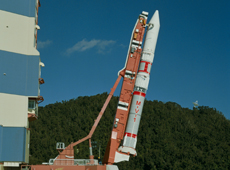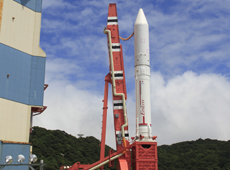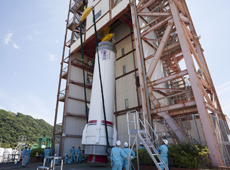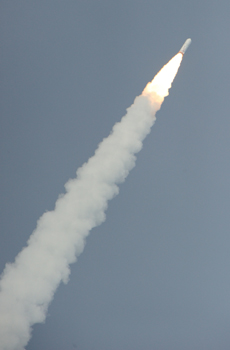
--- How exactly did you modify the M-V launcher for Epsilon?

The M-V rocket’s inclined launch system

Epsilon’s vertical launch system
The major change was the addition of the rocket-assembly work floor. Because Epsilon’s fuselage is about 5 meters shorter than the M-V’s, the location for accessing the rocket from the service structure is different. We added a floor to fit the rocket’s height. We already had the structure, so we just redesigned the interior. In addition, the M-V launched diagonally, while Epsilon launches vertically, so we added a rocket support platform – a launch pad – that can support a rocket pointing straight up.
The other large component we modified was the overhead crane used in rocket assembly, which we strengthened. With the M-V, we split the first stage into two parts to lift them into place, but due to Epsilon’s configuration, we lift the first stage in one piece. That means having to lift about double the weight, so we upgraded the service structure’s overhead crane from 50 tons to 100 tons. We also installed a new flue, which is a tunnel through which combusted gas travels during the launch. With this flue we vastly reduced the effect of launch-time vibrations on satellites.
--- What were the most difficult alterations?
I’d have to say the tough part was how good we could make the equipment within a tight schedule and limited budget. When it comes down to it, it takes time and money to make something better, no matter what. And in fact, right from the start of the project, we found that all kinds of things needed improvements. But if we had decided to pursue all those improvements, we would have been behind schedule and over budget, so we had to assign an order of priority. It was difficult to coordinate those priorities with the personnel we had working on the launch equipment and the rocket itself, but at times I really enjoyed the experience.
--- What made a particular impression on you during the assembly process?

First-stage motor being lifted by crane (courtesy: JAXA/JOE NISHIZAWA)
I was impressed by the fairing assembly work, and the erection of the first stage using the crane. The fairing that houses the satellite in the rocket’s nose was newly developed for Epsilon, by JAXA and Kawasaki Heavy Industries, and assembled by IHI Aerospace. It’s a bit complicated because there are two companies involved, so we practiced assembly in advance with a prototype model. We had many discussions with everyone about the actual assembly process, and I really felt that our technical proficiency improved. That was a great motivator for me, and it was rewarding. In the end we did a good job: we assembled the actual fairing in one try.
Erecting the first stage, on the other hand... The H-IIA Launch Vehicle uses solid rocket boosters, known as SRB-As, for the first stage, but this was our first time assembling SRB-As at the Uchinoura launch site. So, first we practiced handling the equipment using a dummy rocket the same size and weight as the real thing. Little by little, we got the dummy SRB-As upright using the new 100-ton crane and the gantry crane that was already at Uchinoura. When we did that, we found that some of the wiring was interfering with the gantry crane. Although we had checked the diagrams, we had overlooked a minor detail. We then hurriedly arranged for a large crane truck like you see at construction sites, but the adjustments meant we had to suspend work for a few days. During that time I was really worried that the launch might be delayed because of this.
--- Will you upgrade the launch equipment for Epsilon-2?
We’re planning improvements to make repairs to the launcher after blastoff cheaper and more efficient. When we looked at the scorched launcher, the burn marks were as expected, but we found that making just a few improvements would allow us to reuse parts after launch, or that there are cheaper materials we could use for some parts that are going to be destroyed during blastoff anyway. Now we’re making a list of those sorts of things, and we plan to study them, including what effect upgrades will have on cost.
--- Have you worked on rockets ever since you joined JAXA?

Epsilon in flight
This is my seventh year with the agency, and my work has always involved rockets. For my first three-and-a-half years, I worked on ground equipment used to launch the H-IIA and H-IIB rockets at the Tanegashima Space Center. Watching rocket launches in person was such a wonderful experience. On TV they only show 10 seconds or so of a rocket launch, but getting to that point takes a huge amount of time and effort. I was able to see that whole process, and I feel I gained a deeper understanding of what a rocket launch is about.
--- Have you had an interest in space since you were a child?
No. It didn’t interest me at all when I was a kid. I wanted to be a fireman or a bus driver.
--- What made you want to work for JAXA?
I found out about JAXA a year before I graduated from technical college. When I was looking at a list of companies and government agencies offering internships, I saw the word “space” in Japan Aerospace Exploration Agency, and I thought they must be doing something big and interesting. So I came to the Tsukuba Space Center for a one-week internship, and I was assigned to a section where they were doing basic research for experiments to run on the International Space Station. And suddenly, space, which had seemed so distant, felt so near. I was very impressed that there are people who do this kind of thing seriously. So I sat for the employment exam.
--- Do you like working on rockets?
It’s interesting and fun. I was also very moved when Epsilon launched. I had tears running down my face when it lifted off. Perhaps I felt the loneliness of the rocket as it was leaving us, and was moved by its courage as it went up alone toward faraway outer space. It was truly emotional, and I can’t stop myself when I feel that way. A rocket launch is so awesome!
--- But what about when you looked at the scorched launcher after the rocket went away?
That brought me back to reality. I thought, “Oh! I have something new to do!” But even if I had a job that was always fun and where everything always worked out well, I still don’t think it would be as inspiring as my current job during a launch. When the rocket flew away, I’m certain I had these strong feelings precisely because I put had a lot of effort into the launch.
--- Do you remember first hearing about the Epsilon concept?

Yes. I felt it was futuristic when I heard it would be a rocket controlled with a PC. But I didn’t at all think it would be impossible. For some reason I felt certain we could do it.
--- What is your ideal rocket?
My ideal rocket is one you can launch every week, over and over. I’d like launches to become everyday occurrences rather than special events. But for that to happen, we must expand our use of outer space and lower the barriers to getting there. That’s because no matter how good a rocket you have, you can’t launch it without having a payload to send up – satellites, probes and the like.
And as for Epsilon, I would like it to become a rocket with unique qualities. One way to achieve that is to make it an easy-to-use rocket. Satellites launches have various requirements, like altitude and trajectory, and I think one advantage would be to have a rocket with the flexibility to deal with any requirement that might come up. My ideal rocket is one that’s highly adaptable.
--- What is your dream, Mr. Ono?
I just want to keep being involved in developing new rockets, no matter what sort of job it is. Then, after I retire, I want to live in Tanegashima again. I was assigned to Tanegashima soon after JAXA hired me, and I was nervous because it was my first time living alone, but the people around me were very kind and I settled in. There’s lots of nature, the air’s fresh, and the shochu [a distilled spirit] is good. And most of all I want to live there because I can see the rocket launches up close. (Laughs.)
Engineer, Epsilon Rocket Project Team, Space Transportation Mission Directorate, JAXA
Tetsuya Ono graduated from Osaka Prefecture College of Technology in 2007, and that same year joined JAXA, where he was assigned to operations and launch equipment maintenance at the H-IIA and H-IIB launch-vehicle site in Tanegashima. In 2010 he was transferred to the Tsukuba Space Center, where he operates launch-site equipment and works on developing new launch equipment for the Epsilon Launch Vehicle.
Making good rockets requires more simplicity!
Epsilon Technology: A Link to the Future
Epsilon: A Soft and Comfortable Ride
The Anytime, Anywhere Rocket
Building a Versatile Rocket
